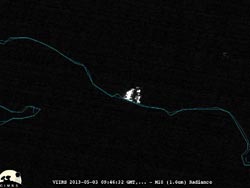Satellite Captures Night-time image of California’s Springs Fire

<br>
The Suomi NPP satellite carries an instrument so sensitive to low light levels that it can detect wildfires in the middle of the night.
The Day/Night band on Suomi/NPP produces Night-Time visible imagery using illumination from natural (the moon, forest fires) and man-made sources (city lights, gas flares).
On May 3 and 4, 2013, the Visible Infrared Imaging Radiometer Suite (VIIRS) on Suomi-NPP acquired animated images of the Springs Fire blazing near Los Angeles, California. The animation clearly shows the fire as a bright white circular area on May 3 near Point Mugu State Park.
As the light of the fire traveled through the smoke, it got scattered (like shining a flashlight through smoke) appears brighter on the satellite image. The bright spot disappeared on May 4 as the blaze was coming under control as a result of firefighting efforts. The animation was created with data from the instrument’s “day-night band,” which sensed the fire in the visible portion of the spectrum.
According to Reuters news on May 6, the Springs Fire consumed as much as 28,000 acres of brush in the coastal area located northwest of Los Angeles. The fire started on Thursday, May 2, and by Sunday, May 5, the weather allowed firefighters to put containment lines around the fire.
Image Credit: William Straka III, University of Wisconsin, CIMSS
Text Credit: Rob Gutro, NASA’s Goddard Space Flight Center
Media Contact
All latest news from the category: Earth Sciences
Earth Sciences (also referred to as Geosciences), which deals with basic issues surrounding our planet, plays a vital role in the area of energy and raw materials supply.
Earth Sciences comprises subjects such as geology, geography, geological informatics, paleontology, mineralogy, petrography, crystallography, geophysics, geodesy, glaciology, cartography, photogrammetry, meteorology and seismology, early-warning systems, earthquake research and polar research.
Newest articles

Sea slugs inspire highly stretchable biomedical sensor
USC Viterbi School of Engineering researcher Hangbo Zhao presents findings on highly stretchable and customizable microneedles for application in fields including neuroscience, tissue engineering, and wearable bioelectronics. The revolution in…

Twisting and binding matter waves with photons in a cavity
Precisely measuring the energy states of individual atoms has been a historical challenge for physicists due to atomic recoil. When an atom interacts with a photon, the atom “recoils” in…

Nanotubes, nanoparticles, and antibodies detect tiny amounts of fentanyl
New sensor is six orders of magnitude more sensitive than the next best thing. A research team at Pitt led by Alexander Star, a chemistry professor in the Kenneth P. Dietrich…





















